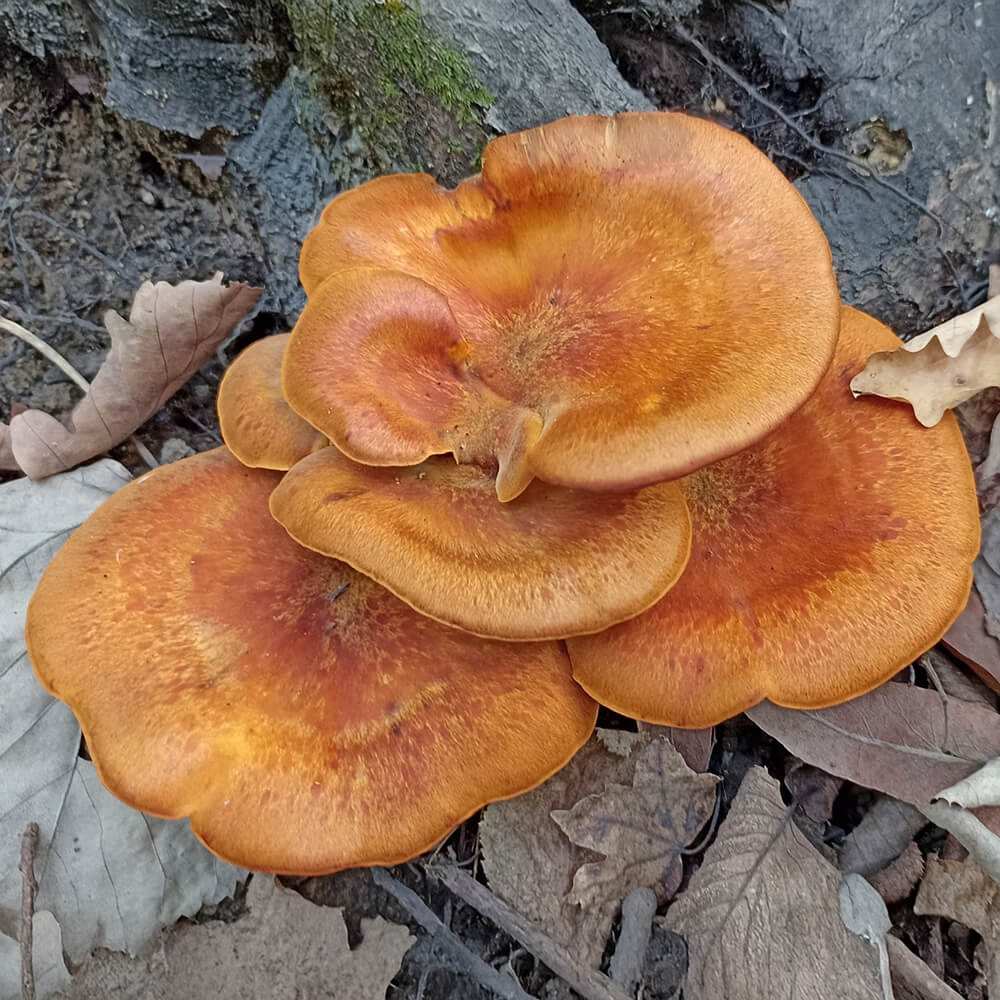Description
What is the Jack-o'-Lantern Mushroom?
The Jack-o'-Lantern Mushroom (Omphalotus olearius) is a strikingly vibrant, orange-gilled mushroom known for its eerie, bioluminescent glow. Native to Europe and parts of North America, this species grows on decaying hardwood stumps and buried roots, often appearing in large, clustered groups.
Though it resembles some edible chanterelles in shape and color, Omphalotus olearius is not edible and contains compounds that may cause gastrointestinal distress if consumed — making it best suited for research and observation, not for culinary use.
Where Does Omphalotus olearius Grow?
This species is most commonly found in forests, parks, and wooded areas across Europe, the eastern U.S., and the Midwest. It typically fruits in summer and fall on decaying wood, particularly oak and beech, and sometimes on buried tree roots — giving the illusion that it grows from the ground.
Its natural glow, caused by a compound called luciferin, has made it a favorite among researchers studying fungal bioluminescence and its potential applications in biotechnology and environmental monitoring.
Unique Characteristics and Study Potential
A Bioluminescent Mushroom with a Cautionary Twist
Omphalotus olearius is famous for its glowing gills, which emit a faint green light visible in total darkness. This glow is a result of a chemical reaction in the gill tissue, and it's one of the few mushrooms in the world that naturally exhibit this trait.
While not deadly, this mushroom contains illudin compounds that can cause nausea, vomiting, and cramps — making it important for public safety education and scientific analysis rather than consumption.
For Research, Identification, and Mycology Education
This species is a prime candidate for educational mycology, fungal biochemistry, and toxicology studies. It offers insight into natural bioluminescence and is often used to teach safe foraging practices by illustrating how toxic look-alikes differ from edible species.
This 12cc liquid culture syringe contains live Omphalotus olearius mycelium, professionally prepared for use on agar plates, hardwood-based media, or other controlled environments.
Order Your Jack-o'-Lantern Mushroom Liquid Culture Today
Add one of nature’s most visually captivating — and scientifically intriguing — mushrooms to your culture library. Whether for classroom use, fungal fluorescence research, or mycological preservation, Omphalotus olearius is a glowing addition to any collection.
Taxonomic Details for Omphalotus olearius
-
Kingdom: Fungi
-
Division: Basidiomycota
-
Class: Agaricomycetes
-
Order: Agaricales
-
Family: Marasmiaceae
-
Genus: Omphalotus
-
Species: Omphalotus olearius
Description
What is the Jack-o'-Lantern Mushroom?
The Jack-o'-Lantern Mushroom (Omphalotus olearius) is a strikingly vibrant, orange-gilled mushroom known for its eerie, bioluminescent glow. Native to Europe and parts of North America, this species grows on decaying hardwood stumps and buried roots, often appearing in large, clustered groups.
Though it resembles some edible chanterelles in shape and color, Omphalotus olearius is not edible and contains compounds that may cause gastrointestinal distress if consumed — making it best suited for research and observation, not for culinary use.
Where Does Omphalotus olearius Grow?
This species is most commonly found in forests, parks, and wooded areas across Europe, the eastern U.S., and the Midwest. It typically fruits in summer and fall on decaying wood, particularly oak and beech, and sometimes on buried tree roots — giving the illusion that it grows from the ground.
Its natural glow, caused by a compound called luciferin, has made it a favorite among researchers studying fungal bioluminescence and its potential applications in biotechnology and environmental monitoring.
Unique Characteristics and Study Potential
A Bioluminescent Mushroom with a Cautionary Twist
Omphalotus olearius is famous for its glowing gills, which emit a faint green light visible in total darkness. This glow is a result of a chemical reaction in the gill tissue, and it's one of the few mushrooms in the world that naturally exhibit this trait.
While not deadly, this mushroom contains illudin compounds that can cause nausea, vomiting, and cramps — making it important for public safety education and scientific analysis rather than consumption.
For Research, Identification, and Mycology Education
This species is a prime candidate for educational mycology, fungal biochemistry, and toxicology studies. It offers insight into natural bioluminescence and is often used to teach safe foraging practices by illustrating how toxic look-alikes differ from edible species.
This 12cc liquid culture syringe contains live Omphalotus olearius mycelium, professionally prepared for use on agar plates, hardwood-based media, or other controlled environments.
Order Your Jack-o'-Lantern Mushroom Liquid Culture Today
Add one of nature’s most visually captivating — and scientifically intriguing — mushrooms to your culture library. Whether for classroom use, fungal fluorescence research, or mycological preservation, Omphalotus olearius is a glowing addition to any collection.
Taxonomic Details for Omphalotus olearius
-
Kingdom: Fungi
-
Division: Basidiomycota
-
Class: Agaricomycetes
-
Order: Agaricales
-
Family: Marasmiaceae
-
Genus: Omphalotus
-
Species: Omphalotus olearius



